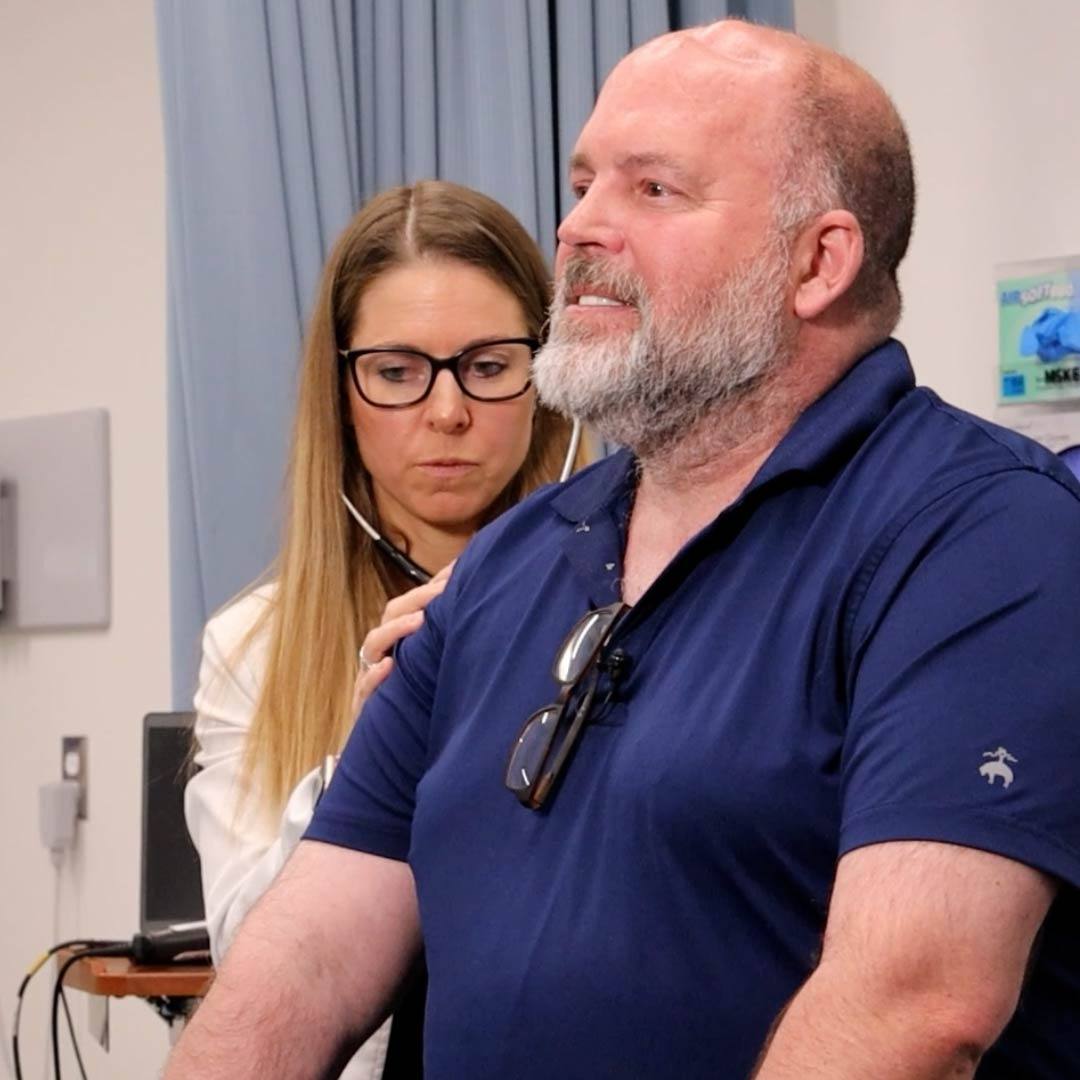Last summer, Scott Walling was in excruciating pain, and he could barely walk. Today he's pain-free and enjoying his favorite hobbies again, thanks to a new procedure offered by Mayo Clinic's Department of Neurosurgery.
One of Scott Walling's favorite activities is trapshooting, especially because it's a pastime he gets to share with his children — two of whom are on a trap shooting team at school.
"It's a different challenge each time you walk out to the line. There are so many factors that you need to overcome: rain, sun, wind speed and direction, and cold," Scott says. "I can't wait for the trap season to start back up this month."
Last summer, the chances of Scott being able to enjoy this year's season with his kids seemed slim. At that time, the 50-year-old road construction worker could barely walk. The back pain he had been experiencing for two years that would shoot down his leg and cause him to feel pins and needles in his toes was getting progressively worse. Scott went to a chiropractor, and he tried steroid medications. Nothing provided consistent relief.
"It got to the point where I was in excruciating pain all day. I wasn't sleeping. It was so bad, it would make me cry," Scott says. "I had to stop working at the end of July."
Scott went to see a neurologist in Mason City, Iowa, not far from where he lives, and he was told surgery would leave him in a wheelchair.
"I couldn't walk or stand up straight. I was hunched over," Scott says. "I had to do something."
That's when he decided to go to Mayo Clinic.
A chance for something better
When Scott arrived at Mayo Clinic in August 2018, he saw Physical Medicine and Rehabilitation physician Karen Newcomer, M.D. After a steroid injection didn't significantly ease his pain, he had a consult with neurosurgeon Mohamad Bydon, M.D.
Dr. Bydon diagnosed spinal stenosis and spondylolisthesis, a condition in which one vertebra slips forward and onto the vertebra below it, causing severe back pain or nerve crowding that produces leg pain or numbness. Dr. Bydon discussed a new surgical procedure with Scott that he was confident would help — a minimally invasive lateral lumbar inner body fusion, followed by robotic placement of posterior pedicle screws.
"Dr. Bydon is a cheerful, wonderful man. He told me, 'This is fixable.' His confidence and his expertise make you feel so comfortable about him. I trusted him immediately."
Scott Walling
"Dr. Bydon is a cheerful, wonderful man. He told me, 'This is fixable.' His confidence and his expertise make you feel so comfortable about him. I trusted him immediately," Scott says. "He kept reassuring me that everything would be OK, and I felt this was the only way I could get back to normal."
The procedure Dr. Bydon proposed to Scott offered a range of benefits. "The robotic software allows surgeons to determine the size of the screws and their trajectories. Then a robotic arm is used to guide the placement of the screws. This provides greater precision and safety when operating near critical neural structures," Dr. Bydon says. "Robotic spine surgery is still in its early stages. But over time, it will help us make surgeries more accurate, safer and more individualized."
After the procedure, patients typically have a shorter hospital stay and less need for narcotic pain medications.
A return to well-being
Mayo Clinic was the first center in the Upper Midwest to offer this robotic procedure and the first hospital nationally to offer it at all its locations. "Robotic spine surgery is available at Mayo Clinic's campuses in Rochester, Minnesota, as well as Florida and Arizona," says Dr. Bydon, who performed the first robotic spine surgery at Mayo Clinic.
On Nov. 1, 2018, Scott was one of the first patients to undergo the procedure. "I went to the world's best hospital. After the surgery, they had me wearing a brace, and I started moving up and down the hallways with the help of the phenomenal nursing staff," Scott says. "When I got home, I wore my brace for eight weeks. Now I get around fantastic. I've been able to spend time outside in my shop."
"The joy on Dr. Bydon's face was awesome. He can definitely put a check in the win column for me."
Scott Walling
By the start of this year, Scott's back and leg pain was gone completely.
"I feel great. With all the walking I've been doing, I'm getting back to where I was before the pain started," Scott says. "I'm able to do everyday basic tasks like cooking or getting dressed by myself, which were difficult before surgery. It's also nice to be able to drive my car and have my independence back."
At his three-month follow-up appointment, Dr. Bydon told Scott he's doing exceptionally well. "The joy on Dr. Bydon's face was awesome. He can definitely put a check in the win column for me," Scott says.
Physical therapy to strengthen Scott's core muscles and the muscles in his back will help him improve even more. In the meantime, he's returned to another one of his favorite hobbies: running a blacksmith shop out of his shed, where he makes items such as plant hangers and grilling utensils.
"I'm grateful for my health and my family. My wife and kids have been so supportive. And I'm thankful for the doctors and nurses and everyone who took care of me," Scott says. "Everybody at Mayo is phenomenal. They're just so concerned about your well-being."
HELPFUL LINKS
- Watch a video to learn more about robotic spine surgery.
- Read about spinal stenosis.
- Check out Mayo Clinic's Department of Neurosurgery.
- Connect with others talking about brain and nervous system conditions on Mayo Clinic Connect.
- Explore Mayo Clinic's Rochester campus.
- Request an appointment.










